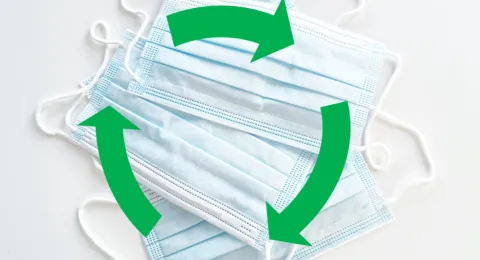Is it possible to reuse and recycle face masks?
I participated in a seminar "Kiertokulku- Etelä-Karjalan kiertotalous nyt ja huomenna" "Circulation- Circular economy now and tomorrow in South-Karelia" organized by Greenreality on 26.-27.9.2023. It considered the on-going projects in the area of circular economy. I know that circular economy extends many ways starting from the design of the products ending up the reuse and services. I did not know that, in the end, it is already applied to the urban planning, nutrient cycling and even production of polyester fibers using carbon dioxide wasted. Why not since the logic of circular economy can be applied almost everywhere. It is gratifying to see that waste sorting is worthwhile since today it is possible to produce biogas for cars out of the biowaste sorted. It is also possible to produce composites out of wood and plastic waste. It was also discussed is it possible today to use the recycled material as efficiently as possible and which factors affect market access. As expected, the price has been the determining factor.
An idea arose from the seminar was that has the single-use face masks been reused and on which kinds of applications? If the high-quality face masks will be recycled back to use, very efficient washing or cleaning procedures and processes are needed. These methods should guarantee that bacteria and viruses have been eliminated. Most probably, the face masks used are easier to cycle for those kinds of applications where extreme cleanliness is not a primary criterion.
Cleaning of the face masks is important
The general perception is that surgical masks and respirators used in hospitals can not be recycled, especially back to use after cleaning. The face masks are in contact with mouth and nose, so the material used should be clean from pathogens and safe to use without chemical residues and odors. And the quality of the fibers used in the face masks should be excellent in order to achieve good filtration properties. During the manufacture of face masks, an electrostatic charge is added to the middle filtration layer to improve the filtering efficiency that can be damaged during the cleaning procedures.
Personal protective equipment (PPE) are intended and manufactured for single-use. Due to the shielding gap brought by the COVID-19 pandemic, lots of research was made on the cleaning methods and reuse of the face masks used. There exists lots of cleaning methods, such as UV radiation, dry and moist heat treatment, autoclaving and steam treatment produced by microwave. From the chemical treatments, alcohol/ethanol, ethylene oxide, bleach chemicals or vaporized hydrogen peroxide have been mostly applied (Derraik et al. 2020, G. Varghese et al. 2022). The most used of these methods are probably heat treatment and UV radiation which can be put into practice on a large scale and quickly without the need for special equipment, like for hydrogen peroxide treatment (Laatikainen et al. 2022). It has been studied that treatment with UV radiation (UVC, 200-280 nm, 1500-2000 mJ/cm2) or with heat at 60–65 °C for 90 min or at 70–75 °C for 60 min leads to inactivation of coronavirus (SARS-CoV-2) from the surface of respirator made of polypropylene (Derraik et al. 2020). It was, however, stressed that the exact cleaning conditions and times are model specific. At total, five cleaning cycles were recommended (Derraik et al. 2020).
As discussed by Kiiskinen (2021), several things affect the cleaning results of face mask when UV radiation has been applied. For example, weight of the fabric used, thickness, porosity, chemical composition of fibers, color pigment used, foldings of the face masks, level of contamination, amount of foundation or sunscreen affects the cleaning result. Overall, these issues make the cleaning process extremely challenging.
Studies published by VTT have shown that filtrating properties of single-use surgical mask is similar to the cloth mask after ten washing cycles using boiling or machine washing (VTT 2020). It was, however, shown that the filtrating efficiency of the surgical mask deteriorates in such a way that it can not be used in professional use. As has also been earlier shown for alcohol treatment (Derraik et al. 2006, Kiiskinen 2021), most probably the washing with water removes the electrostatic charge of the filtrating, decreasing the filtration efficiency of the face mask.
Applications for recycled face masks
There exist lots of applications where face masked have been utilized. The polymer used in the face masks is thermoplastic, i.e. it is possible to melt the polymer and re-manufacture it, for example, into pellets. First googling gave a news from Helsingin Sanomat that garden chairs and car parts have been made out of face masks (Helsingin Sanomat, 19.5.2021). In a broader review, much more applications for face masks used were found, such as:
- as a reinforcment in building materials (Idrees et al. 2022, Vitacore 2023),
- asphalt-based road surface (Saberian et al. 2021, RMIT-University 2021).
- sound porous adsorbers (Maderuelo-Sanz et al. 2021),
- in manufacturing of plastic visors (Plaxtil, 2020).
- polypropylene microfibers pre-treated in graphene oxide solution to reinforce cement (Li et al. 2022).
- nitrile-rubber -compound (G. Varghese et al. 2022)
- white light emitting LEDs (Perikala and Bhardwaj, 2022).
- wood and composite applications (TerraCycle, 2023)
- in manufacturing of pyrolysis oil (Fraunhofer Institute UMSICHT, SABIC and Procter & Gamble, Textile technology, 2021)
- garden chairs and tables (Thermal Compaction Group, 2023)
- school chairs and toolboxes (Sky news, 2021)
Processing methods for used face masks
The face masks used have went through different processing methods. In one of them, they have been collected, grounded, combined with binder, cleaned and finally recycled. For example, TerraCycle sends and collects the PPE used in Zero Waste boxes, qualifying surgical masks, KN95 and N95. The company also sorts the waste and sends it to the production of pellets and granulates. These pellets and granulates can be used in wood and composite applications (TerraCycle 2023). The metal nose clips have been also separated and used for manufacturing of metal sheets.
One option for the face masks is pyrolysis where shredded masks are converted to pyrolysis oil by thermochemical means (Textile technology 2021). The pyrolysis process breaks down the plastic into molecular fragments using pressure and heat. It also destroys any contaminant or pathogen , including the coronavirus.
Conclusions
As seen above, recycling of face masks used is possible and there are numerous applications published. If face masks are wanted to be cleaned for professional healthcare use, the cleanings methods should be effective, easy and not destroy the electrostatic charge attached to the polymer during manufacture. Since the face masks have been made of different materials or probably coated with some substance or contain dirt, such as foundation or sunscreen, the cleaning is extreme difficult. Another challenge is the cost of cleaning. Will it be always more expensive than buying a new one? However, it is important to study the cleaning mechanisms since they will be needed when masks are in short supply, like during the COVID-19 pandemic.
Could there be a combination with different cleaning methods described or totally new cleaning method solution to this problem? Is there still more applications for face masks and PPE yet not discovered to recycle the waste generated? Could the image of the future be such that a nurse could push a button of a device to make a brand new cleaned face masks out of the used ones that will fit in her/him face perfectly and have as good filtration properties as the original. It remains to be seen.
References
Fant, S. (25.1.2022), Recycling Covid masks: here are those who attempt it around the world. https://www.renewablematter.eu/articles/article/recycling-covid-masks-h….
Derraik, J.G.B., Anderson, W.A., Connelly, E.A. et al. and Anderson, Y.C. (2020). Rapid Review of SARS-CoV-1 and SARS-CoV-2 Viability, Susceptibility to Treatment, and the Disinfection and Reuse of PPE, Particularly Filtering Facepiece Respirators. Int.J.Environ.Res. Public Health 17(17): 6117.
George Varghese P. J, Deepthi Anna David, Anas Karuth, Jabeen Fatima Manamkeri Jafferali, Sabura Begum P. M, Jinu Jacob George, Bakhtiyor Rasulev and Prasanth Raghavan (2022). Experimental and Simulation Studies on Nonwoven Polypropylene− Nitrile Rubber Blend: Recycling of Medical Face Masks to an Engineering Product. Acs Omega, 7, 4791-4803.
Helsingin Sanomat (19.5.2021). Maailmassa käytettiin viime vuonna liki 130 miljardia kasvomaskia joka kuukausi – Jäteongelmaa hillitään valmistamalla maskeista puutarhatuoleja ja autonosia.
Idrees, M., Akbar, A., Mohamed, A.M., Fathi, D. and Saeed, F. (2022) Recycling of Waste Facial Masks as a Construction Material, a Step towards Sustainability, Materials (Basel) 15(5): 1810.
Kiiskinen, T. (2021). Mikrobien desinfiointi ultraviolettisäteilyllä suu- ja nenäsuojaimista. Kandidaatintutkielma, Biokemian ja molekyylilääketieteen tiedekunta, Oulun yliopisto. 33 pp.
Laatikainen, K., Mesilaakso, M., Kulmala, I., Makela, E., Ruutu, P., Lyytikainen, O., Tella, S., Humppi, T., Salo, S., Haataja, T., Helminen, K., Karppinen, H., Kahkonen, H., Vainiola, T., Blomqvist, K., Laitinen, S., Peltonen, K., Laaksonen, M., Ristimaki, T. and Koivisto, J. (2022). Large-scale decontamination of disposable FFP2 and FFP3 respirators by hydrogen peroxide vapour, Eurosurveillance, 27(11).
Li, Z., Zhang, Z., Fei, M-e and Shi, X. (2022). Upcycling waste mask PP microfibers in portland cement paste: Surface treatment by graphene oxide. Materials Letters 318, 132238.
Melillo, G. (12.8.2022). https://thehill.com/changing-america/sustainability/environment/3597482….
Maderuelo-Sanz, R., Acedo-Fuentes, P., García-Cobos, F.J., Sánchez-Delgado, F.J., Mota-López, M.I. and Meneses-Rodríguez, J.M. (2021). The recycling of surgical face masks as sound porous absorbers: Preliminary evaluation. Science of the Total Environment 786, 147461.
Perikala, M. and Bhardwaj, A. (2022). Waste to white light: a sustainable method for converting biohazardous waste to broadband white LEDs. RDS Adv. 12(18), 11443-11453.
Plaxtil (27.8.2020). https://www.france24.com/en/20200827-face-mask-recycling-french-firm-fi….
RMIT-University (3.2.2021). https://www.rmit.edu.au/news/all-news/2021/feb/recycling-face-masks-int….
Saberian,M. Li, J., Kilmartin-Lynch and Mahdi Boroujeni, S. (2021). Repurposing of COVID-19 single-use face masks for pavements base/subbase, Science of the Total Environment, 769, 145527.
Sky News (13.4.2021). COVID-19: 'Game-changing' PPE recycling technology turns masks and gowns into school chairs https://news.sky.com/story/covid-19-game-changing-ppe-recycling-technol….
TerraCycle (2023). https://www.terracycle.com/en-CA/pages/ppe-recycling. Read 5.10.2023.
Textile technology (2021). Joint forces in recycling for facemasks. https://www.textiletechnology.net/technical-textiles/news/fraunhofersab…
Thermal Company Group (2023): COVID-19: 'Game-changing' PPE recycling technology. https://www.tcgsolutions.co.uk/blog/covid-19-game-changing-ppe-recyclin…
Vitacore (2023). https://www.vitacore.com/recycling-program. Read 5.10.2023.
VTT (16.10.2020), VTT selvitti, ovatko kertakäyttöiset suojaimet ja kangasmaskit puhdistettavissa kotikonstein. https://www.vttresearch.com/fi/uutiset-ja-tarinat/vtt-selvitti-ovatko-k….
Krista Koljonen, Project manager of BioProt
You can find this text also In Finnish here.
More information

Eveliina Repo


